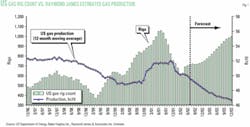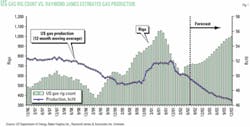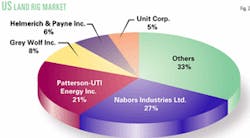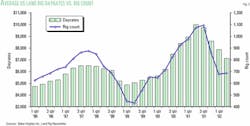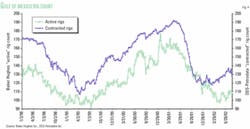SPECIAL REPORT: US drilling business poised for strong 2003 recovery
Within the next 2 years, drilling activity should reach the limit of existing rig capacity, prompting drilling-rig new builds as the US oil and gas industry struggles to restore natural gas production rates.
Before new builds hit the market, 2003 rig utilization will first move upward, driving rig dayrates sharply higher and giving birth to yet another up cycle in the highly volatile drilling business.
The only certainty in the oil patch is volatility. Drilling activity is no different. In only the past 4 years, the US rig count has gone from a record low to a 15-year high and back again.
Why the volatility? Simply put, the rig count follows oil and gas prices. With the 1999 collapse in oil prices to a mere $10/bbl, the Baker Hughes Inc. US rig count fell to a record low of only 488 rigs in operation.
The subsequent cut in oil production by OPEC—its first act of cohesion in numerous years—boosted oil prices back into the $25-30/bbl range by yearend.
This rise in oil prices, coupled with rising natural gas prices, drove a steady rise in the rig count until reaching its peak of 1,293 rigs in July 2001, the highest level since 1986.
In the past year, US drilling activity has come full circle once again. From the July peak last year, the US rig count fell nearly 43% to an April 2002 low of 738 rigs. Natural gas prices retreating from the double-digit gas prices experienced in the 2000-01 winter drove this decline.
Going forward, the natural gas-driven drilling market once again looks poised to break above the robust drilling activity levels set in the summer of 2001.
US natural gas supply is falling at a record pace, and the gas demand prospects for the upcoming winter appear very favorable, especially when compared to the anemic gas demand seen during last year's record warm winter weather.
As a result, natural gas prices are setting up for an extremely robust 2003 and beyond. Since about 80% of all US drilling is now natural gas driven, natural gas prices will be the key variable to watch to predict future US drilling activity levels.
Gas prices drive rig counts
Despite near-term concerns with excessive gas storage, the converging supply-demand trends this winter and next year suggest we are headed back towards much higher natural gas prices in 2003.
Obviously that bodes well for drilling contractors. What is different this time around? First and foremost, natural gas supply is falling much faster than during anytime in history.
Recent results from US gas producers suggest that US supply has been drifting down roughly 1.5%/quarter on average for the past year.
This drop equates to a year-to-year decline in the 5-6% range and is a direct result of the 45% drop in natural gas drilling activity since mid-2001 (Fig. 1).
The muted response in drilling activity so far this year suggests that this downward year-over-year gas supply trend is likely to remain in place through much of 2003.
In fact, we believe that the only way that US gas producers can reverse this negative trend is to take gas-drilling activity above those levels experienced in the recent July 2001 peak.
As Fig. 1 shows, we expect a sharp rebound in US gas-related drilling through 2003. Unfortunately, it will likely be too late to reverse the deteriorating gas supply trend next year.
On the gas demand side of the equation, many are underestimating the potential year-over-year gas demand increases that are likely this winter.
The "gas price bears" are simply ignoring the fact that there are very easy comparisons for both weather and the economic picture as compared to last year.
On the weather side, the winter of 2001-02 represented the warmest winter in history at nearly 15% warmer than normal. By our calculation, this equates to the loss of 6-8 bcfd relative to normal winter conditions.
Since average annual gas consumption is about 60 bcfd, the warm weather last year accounted for a huge gas demand reduction.
While we are not calling for a normal winter this year—we gave up on normal winters long ago—there are extremely high statistical odds that the winter of 2002-03 will be colder than last year. That would mean a year-to-year gas demand increase, regardless of the trends in the overall economy.
The story is similar on the economy-driven gas demand side. Industrial production, recorded by the Institute for Supply Management, formerly the National Association of Purchasing Management (NAPM), has proven a good historical proxy for industrial gas demand.
It too was at its worst during the winter of 2001-02. The post-Sept. 11 economy was running down about 5% from the year earlier.
Hence, even if the economy doesn't improve dramatically from current levels, there is a good chance that easy year-over-year comparisons will show an increase in industrial-related gas demand this winter over last winter.
What do all these numbers mean? In a nutshell, the US is likely to see a natural gas market that will be even tighter this winter than the $10/Mcf winter of 2 years ago.
Given the record warm weather and poor economy last winter, this tightness is likely to occur almost regardless of the economy or weather. More importantly, this time it will be much harder to fix this under-supplied US gas market than it was the last time gas prices spiked.
Since this is more of a supply-driven shortage than a demand-driven shortage, we think it is likely that gas prices will remain very robust through all of 2003.
Either way, we believe natural gas prices are headed to well above $4/Mcf this winter, which should drive an all-out rig boom over at least the next 12 months.
Land rigs benefit
The land rig market has taken a dramatic turn for the better over the past 5 years. A few large players have consolidated what was once a highly fragmented "mom and pop" market.
Continued consolidation efforts by the likes of Nabors Industries Ltd., Patterson-UTI Energy Inc., Grey Wolf Inc., and Unit Corp. as well as a new-build program implemented by Helmerich & Payne Inc. over the past couple years has driven this trend.
Today, the top five players hold roughly two thirds of the nearly 1,500 land rigs that exist (Fig. 2).
Industry consolidation, a smaller rig fleet size, and a rejuvenated drilling effort—this time focused on natural gas—have all combined to make the drilling business a much healthier industry over the past several years.
In fact a squeeze on land rigs during the 2000-01 run-up drove dayrates to levels not witnessed since the 1973-81 boom as contractors struggled to bring out older, stacked equipment as quickly possible (Fig. 3).
All told, drillers spent more than $500 million in capital to reactivate more than 200 rigs, driving the active rig count up from fewer than 500 in early 1999 to nearly 1,300 rigs in mid-2001.
Of the remaining 200-250 rigs that could reenter the market upon refurbishment, the top five contractors still own nearly 75%.
Probably the best indicator of industry health was more evident during the recent down-cycle. For the first time in 20 years, rig pricing did not completely fall apart in the downturn.
Average US land rig dayrates today remain at around $7,000/day, compared to 1999 downturn levels of less than $4,900/day. In fact, US land-rig dayrates today are about $500/day higher than the average peak level reached in the 1997 boom.
Since onshore basins of the US account for about 65% of supply, we suspect another run on rigs is in the making as operators take advantage of higher expected natural gas prices and fight to stabilize the sharply deteriorating US natural gas supply situation.
Unfortunately, this may be more difficult than many think. During oil drilling in the 1970s, a three fold increase in Lower-48 oil drilling activity yielded a 30% drop in oil production over the course of the decade.
When you run out, you run out. Either way, we believe the market demand for natural gas rigs will continue to work its way sharply higher in 2003, eventually calling for substantial drilling rig new-builds in the next couple of years.
With pricing for certain rigs already having reached replacement cost levels during 2001, new-builds are clearly not a far-fetched concept. In the mean-time, you can expect land drilling activity to improve fairly rapidly once operators get comfortable with higher natural gas prices beginning this winter.
Offshore market benefits
While not as directly tied to natural gas, the offshore rig market also appears poised for improvement heading into next year.
Thanks to falling natural gas prices last winter, the gas-driven, jack up rig activity and pricing have suffered the greatest deterioration in activity.
Meanwhile, the deepwater rig market has remained relatively healthy, as oil prices have held up much better and longer-term deepwater contracts have blunted the recent downturn.
Market indicators on current activity levels provide somewhat mixed signals. There has historically been a very close correlation between the number of "active" rigs measured by Baker Hughes and the number of "contracted" rigs measured by ODS-Petrodata Group.
Since early 2002, however, there has been a divergence in the data. Fig. 4 shows that the number of contracted rigs bottomed near the start of the year and has posted a consistent rise ever since.
At the same time it appears that the number of active rigs did not reach bottom until about May, at which point the count trended sideways for another couple weeks.
Since then, however, the number of active rigs has begun to catch up with the level of contracted rigs. While we are unsure of the exact reason for the divergence, the improved level of contracted rigs does portend well for the future outlook of US offshore drilling activity.
Furthermore, our expectations for improving natural-gas prices coupled with the added incentive of royalty relief for deeper targets in the Gulf of Mexico's shallow-water region is sure to drive the jack up rig count higher over the next 12-18 months.
This rise in demand in conjunction with about 20 fewer rigs, all of which have relocated to international markets, should drive dayrate improvements as well. In some cases this has already begun to occur.
For deepwater and ultra-deepwater rigs, nothing much has changed. Many of the deepwater rigs remain locked up under multiyear contracts, with some of these coming up for renewal over the next year.
If development drilling from the numerous deepwater discoveries does not come to fruition fairly soon, there could be some near-term softness in the deepwater rig market as some of these contracts come up for renewal.
Since beginning a wave of new-builds in 1997, there have been more than 50 new rigs delivered to service the deepwater market.
Additionally, there have been a number of older generation semisubmersibles that have undergone significant upgrades to enable them to operate in deeper water depths.
From an economic perspective, the incremental dayrates generated from the upgrades provided much better returns on average than a fifth generation new-build.
There has also been a recent trend towards the construction of new heavy duty, harsh environment, and ultra premium jack ups. These new rigs are perfectly suited to drill deeper horizons, which now have the added incentive of royalty relief from the US Minerals Management Service.
Strong recovery
Even though the health of the drilling business has improved dramatically over the past 5 years, extreme volatility persists.
Fortunately for contractors, the next swing is likely to be in the upward direction. As the US struggles to stabilize a rapidly deteriorating natural gas production base, the only near-term solution is to drill more holes in the ground.
We expect the US drilling rig count will turn sharply upward this winter. After it starts upward, it will be a race to see how many rigs contractors can outfit and staff through 2003.
Within the next 2 years, drilling contractors are finally going to "hit the wall" with existing capacity and new builds will soon follow.
That also means that drilling dayrates are poised to explode next year and will more than double from current levels before we see substantial new-build capacity enter the market.
The authors
J. Marshall Adkins is managing director of energy research and senior oil field service equity analyst at Raymond James & Associates Inc. Adkins started his career with BJ Services Co. as an engineer, salesman, and financial analyst and worked for another advanced oil field technology company prior to joining Raymond James. He has a BS in petroleum engineering and MBA from the University of Texas, Austin.
Jim Rollyson is an energy analyst and has been with the Raymond James & Associates Inc. oil field service research team for nearly 5 years. He has a degree in finance, with a minor in economics from the University of South Florida, Tampa.
